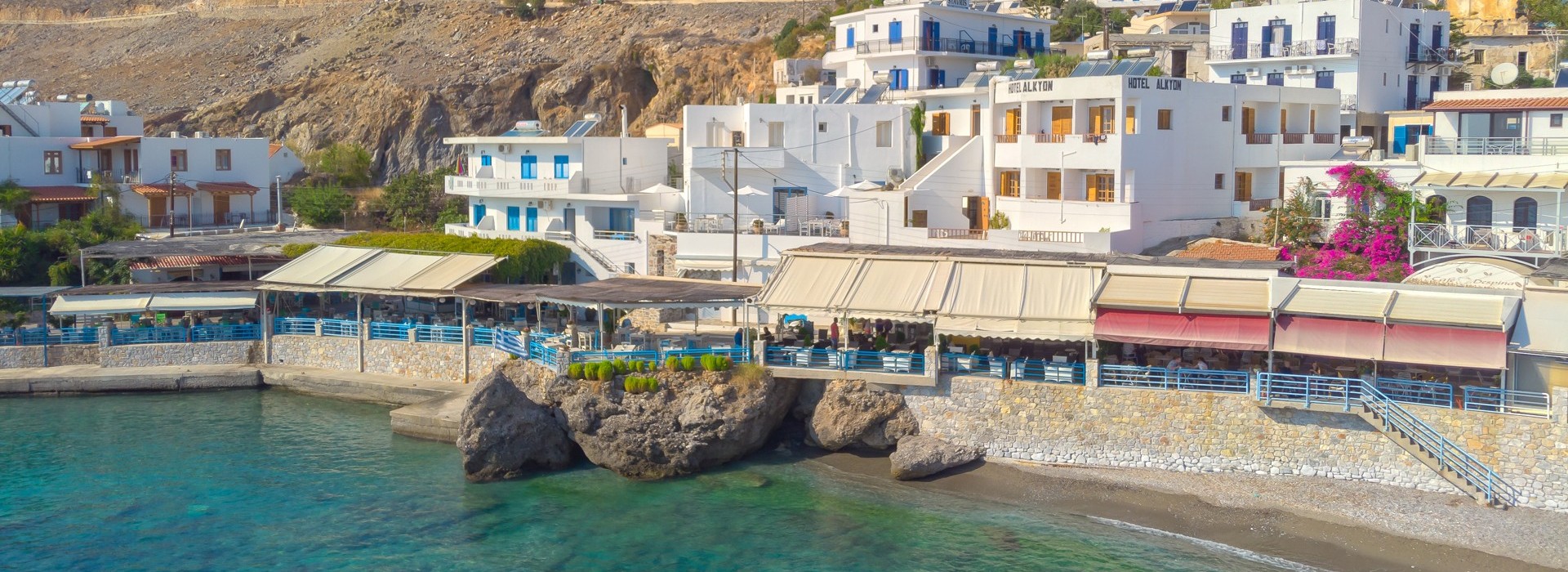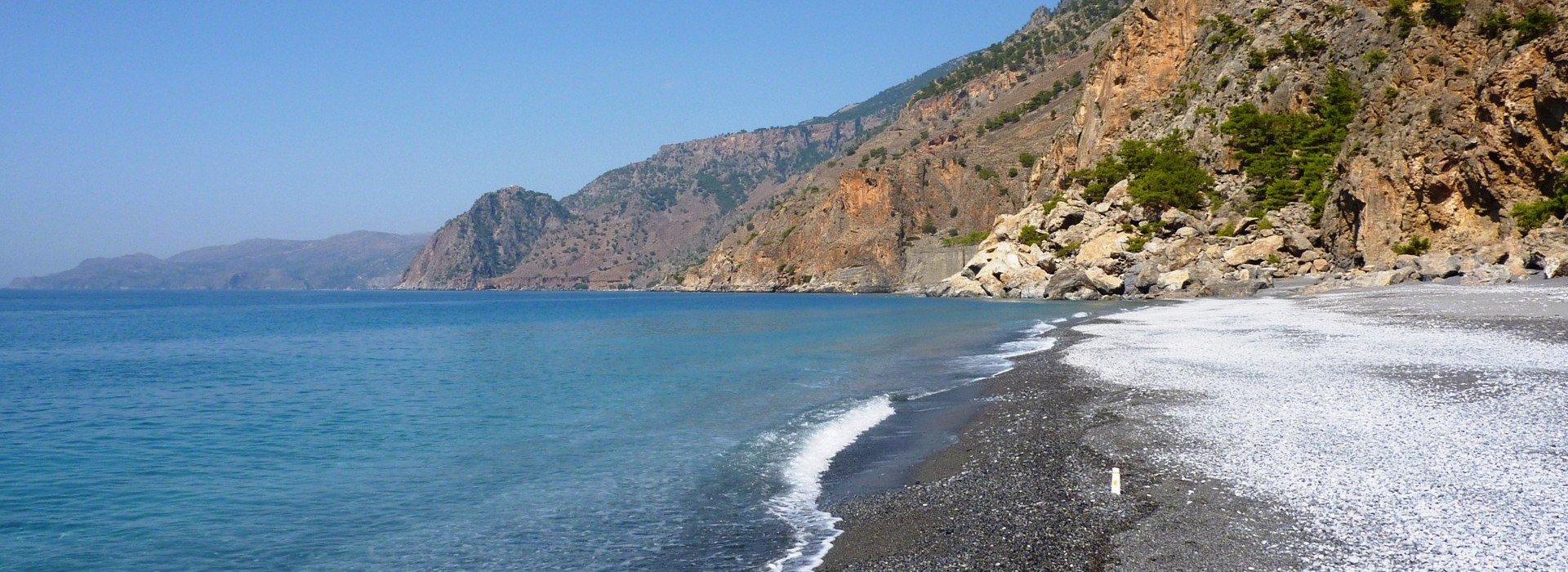Villas on the south coast, area information

Sfakia is one of the largest municipalities in Greece, but the inhabitants are merely around 2,500. The municipality stretches from the area of Apokoronas in the north to Chora Sfakion in the south. This is a wild and beautiful part of Crete with unique nature and a unique people. Sfakia is mountainous province where the Lefka Ori Mountains reach their highest peaks. With Pahnes at 2,453 meters above sea level, this is the second highest peak on Crete. Lefka Ori has 40 peaks over 2,000 meters, all within the Sfakia municipality. In addition, Sfakia is known for its numerous (about 50) gorges/ravines, most of them ending at the sea.
The Sfakia coastal area is exempt from charter tourism and large hotel development. The apartments, small hotels and restaurants which exist are mostly family-run businesses, and life passes at a leisurely pace. Chora Sfakion is port to ferries sailing along the coast, and south to the island of Gavdos. One ferry-route sails west ending in Paleochora, the other sails to the island of Gavdos, Europe’s southernmost point. From the city of Chania the drive takes approximately 1 hour and 20 minutes to Chora Sfakion.
Sfakia is of my favorite areas in Crete and the information below describes the coastal areas starting east at Frangokastello and westward up to Domata-Kalogeros.

Frangokastello is named after the Venetian castle on the beach. It is a nice and peaceful little place with a few small hotels and rooms for rent, and a few restaurants and cafés. The sandy beach is clean, the sea shallow and crystal clear and is perfect for swimming for young children. There are sun beds and umbrellas for rent on the beach. Frangokastello is susceptible to wind and sand storms which can occur in high summer. Check the weather forecast before you visit this lovely place; if the prediction is more than Beaufort force 5 from the north or south, somewhere else on the south coast would be more comfortable. A few hundred meters east of Frangokastello is the beach of Orthi Ammos. The word means “upright sand” and reflects the high sand dunes extending from the cliffs into the sea. The sandy beach is lovely and clean with crystal clear waters, and you need to bring your own umbrella. Just above the beach are 2 small restaurants, one belonging to a nice small hotel, Fata Morgana. From Frangokastello and westwards towards Chora Sfakion you will pass a couple of small pebble beaches with beautiful waters. These are visible from the road and are nice, secluded locations with total peace and tranquility.

Chora Sfakion (or just Sfakia as the locals call it) is the main village in this area, quaint and charming. The long beach promenade is home to a number of good restaurants and cafés. Sfakia is especially known for its excellent food. My favorite restaurant is Ombrosgialos (no.2 from the beginning of the promenade) owned by the siblings Manoussos and Paula. Paula’s specialty is scampi risotto with ouzo and tomato, a wonderful dish!

Chora Sfakion has two small pebble beaches, crystal clear waters and a good range of small hotels and rooms for rent. It is a perfect place to stay if you want to explore this part of Crete. You can drive eastwards along the coast or north into the mountains visiting more beautiful small villages such as Aradena and Anopolis. You can also take the ferry (which takes cars) westwards and stop in Loutro, Agia Roumeli, Sougia or all the way to Paleochora. From Chora Sfakion the ferry also sails a couple days a week to Gavdos. Just off the ferry dock you can hire a taxi-boat from my friends, brothers Damulis and Lefteris. They can bring you to the pearls along the coast, whether only for transportation or for an entire day trip. On days with little wind, they can also bring you to the island of Gavdos in one hour. Damulis and Lefteris also run the area’s diving center, have boat rentals, and arrange boat trips. Contact Damulis on mob. (+30) 6947270106 for taxi-boat, boat rentals, and diving (www.notosmare.com).

Between Sfakia and Loutro you can walk, drive, or take a boat to the small pebble beach of Ilingas. The next beaches are Sweet Water Beach (has a small café), Timios Stavros Beach, and Pervolakia Beach. Sweet Water Beach is named after the many sources of fresh water on the seabed. When swimming here you’ll be amazed at how fast the water temperature changes from meter to meter.

Further west along the coast is Loutro, the south coast now-known gem. Loutro is a perfect place to visit either for a day trip or for several days. This small village is located on the waterfront of a beautiful bay with crystal clear waters. You can only reach it by foot, by ferry, taxi-boat or private boat. From the ferry-landing at one end of the village you enter straight into the tiny main street winding under the restaurants’ and hotels’ pergolas. All restaurants have good food, and a tradition for proudly showing their specialties in glass food-warmers. In Loutro you can see fishing boats moor at the footsteps of the restaurants delivering fresh fish of the day. In the evenings, visitors enjoy their terraces and balconies, or the restaurants and cafés on the waterfront while the moon shines on the ocean and the high encircling mountains. Loutro is normally quiet by midnight, and guests are encouraged to respect the customs and traditions of peace and modesty. All the hotels are cozy and authentic, and run by families who have lived here for generations. Loutro has a pebble beach with umbrellas and sun beds in the middle of the bay, and another small beach across the bay from the ferry-landing. There are kayaks for rent to explore the bay and the nearby coast which includes several small, wonderful beaches. The next area westward is Finikas, Lykos and Marmara.

Finikas and Lykos are two small lovely beaches with a few building each; a few rooms for rent, and a restaurant. They are located at one side of the bay of Phoenix, and can be reached by foot from Loutro or Aradena (the village in the mountains), by taxi-boat, or private boat.
On the other side of the bay of Phoenix is Marmara, (the Greek word for marble). Marmara is reached by foot from Loutro (about 1 hour), by a passenger boat in the morning returning in the afternoon, taxi-boat, or private boat. Hiking the Aradena gorge is one of the great trips in the area, and ends at Marmara. Marble- type gently sloping rocks surround numerous beautiful open caves along the coast, a perfect place for swimming and snorkeling, delighting both children and adults alike. The pebble beach has umbrellas and sun beds, and the sea here has unforgettable colors providing memories for life. I have rarely seen such wonderful azure and turquoise waters anywhere in Greece.

Some steps above the beach, my friend Chrisostomos has an exquisite little taverna and a 3 rooms for rent. Marmara only has solar panels and generators for electricity, and limited fresh water. The menu is small, but includes dishes of locally produced vegetables, cheeses, delicious food on the grill, confit of lamb, and the specialties: amazing homemade bread, and roast lamb and potatoes in olive oil with local herbs, cooked in a wood-burning oven. Both the lamb and the olive oil come from his own production in Aradena in the mountains above. Limited electricity and fresh water makes Marmara mainly a daytrip destination, but if you’re looking for a few days of relaxation, first class food, incredible waters, and unpretentious accommodation, I would definitely recommend renting one of the three rooms available.

Further west along the coast is the beach of Agios Pavlos named after the Byzantine church on the waterfront. The beautiful frescoes in the church are believed to be from the 13th century. The waters are amazing and you can have a simple lunch in the tiny tavern on the beach. Agios Pavlos is only accessible by foot or by taxi-boat, or private boat.

Agia Roumeli is perhaps best known as the village where the famous Samaria Gorge of 18 km ends in the sea. During mid-day, the village is bustling with walkers who have hiked the six-hour trip which begins in the mountains at Omalos on the northern coast of Crete. From Agia Roumeli you can take the ferry either west to Sougia and Paleochora or east to Loutro and Chora Sfakion where buses to Chania correspond with the ferry-times. The “South Coast in a Nutshell” is a lovely day trip combining car and ferry. You can begin in Chania, drive across the beautiful mountains, and arrive at Chora Sfakion from where you take the car on the ferry sailing westward Loutro and on to Agia Roumeli where it stops for about 3 hours. In Agia Roumeli you can spend your time swimming and have lunch before taking the ferry further west to Sougia or all the way to Paleochora. From Sougia or Paleochora is it approximately 1.5 hour drive back to Chania, again over the mountains and through lovely little villages, but with different scenery compared to the Chania to Chora Sfakion drive. Agia Roumeli is also a nice base for a couple of lazy days on the south coast if you want to discover the nearby perfect deserted beaches only accessible by taxi-boat or private boat. There is a good selection of rooms for rent in Agia Roumeli, and the quiet evening mood is very enjoyable.

Domata and Kalogeros are the last of the many pearls along coast I cover on this page. Again, these beaches are only accessible by foot, taxi-boat, or private boat. They are completely deserted, have amazing waters, mountain walls and trees that provide shade, and are small paradises where you can spend a whole day if you really want to get away from it all.

About the climate in Sfakia along the coast:
This stretch of coast (apart from Frangokastello) has a rather unique microclimate, especially during summer. The high mountains protect the coast from the predominant winds of the north (particularly in June, July, and August). They contribute to the sea being calm and only gentle breezes, making this part of the south coast ideal for all types of water and boating activities.

– ”Two days in Sfakia is like a week anywhere else”
Alexandra

Useful links for information on the E4:
Google Trekker – Crete Mountains
Google Trekker – Hiking Trails in Crete
http://www.discoveronfoot.com/walking-in-crete/the-e4/
http://www.chania-crete-greece.com/walking-e4-trail-chora-sfakion-loutro-agia-roumeli.html
FILM CLIPS FROM THE SOUTH COAST
Swimming holidays on Crete, South Coast
Tsatsiki, movie trailer
Loutro Village
Loutro Crete – Λουτρό Κρήτη
Yeah..Crete!
Marmara 2014 av Nils Arvid Jordal
Explore Sfakia – Crete
Hora Sfakion And Loutro, Crete Amazing Drone Footage
Crete Chania Sfakia boat trip
Marmara 2014 by Nils Arvid Jordal
See Friends of Marmara on facebook
Notos Mare Marine Adventures, diving, boat rentals, taxi-boat
